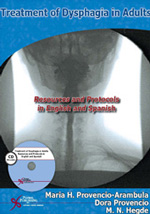
Treatment of Dysphagia in Adults: Resources and Protocols in English and Spanish
First Edition
Maria H. Provencio-Arambula, Dora Provencio, M.N. Hegde
Details: 331 pages, 2-Color, Softcover Layflat, 8.5" x 11"
ISBN13: 978-1-59756-096-2
© 2007 | Available
For Instructors
Purchase
Designed to complement Assessment of Dysphagia: Resources and Protocols, this treatment manual provides all the background information and protocols you need to follow for successful treatment outcomes. The resource section of the book offers background information and treatment overviews for dysphagia and evaluates the advantages and disadvantages of the various procedures. Thereafter a range of protocols provide treatment programs and exercises in an easy to follow format. Again, protocols and exercises are provided in both English and Spanish and the book is accompanied by a free CD-ROM with modiafiable and reproducible forms in Word.
Reviews
"Four stars from Doody's Review Service!"
—Doody Enterprises, Inc.
"This excellent resource for beginning clinicians gives detailed instructions for specific dysphagia therapy techniques, as well as evidence supporting each one...This is a comprehensive and easy to understand resource..."
—Katy Higham, B.A., George Washington University, Doody's Review Service
- Preface
- Introduction to Dysphagia Treatment Resources and Protocols
- How to Use the Accompanying CD
- Section 1. Overview of Management and Treatment of Dysphagia
- Establishing a Prognosis for Treatment
- Components of a Dysphagia Treatment Program
- Preparation for Treatment
- Varieties of Treatment
- Section 2. Management and Treatment of Dysphagia
- General Treatment Procedures
- Protocol 2.1 (English/Spanish): Cheek Push Strategy
- Protocol 2.2 (English/Spanish): Mouth Rinse Strategy
- Protocol 2.3 (English/Spanish): Strong Hold Food Strategy
- Protocol 2.4 (English/Spanish): Multiple Swallow Strategy
- Protocol 2.5 (English/Spanish): Alternating Solids and Liquids Strategy
- Protocol 2.6 (English/Spanish): Empty Mouth Strategy
- Section 3. Treatment for Oral Preparatory Phase Disorders
- Overview of the Oral Preparatory Phase of Swallowing and Associated Disorders
- Increasing Oral Sensitivity
- Protocol 3.1 (English/Spanish): Cold Lip Rub
- Protocol 3.2 (English/Spanish): Warm Lip Rub
- Protocol 3.3 (English/Spanish): Soft Lip Press
- Protocol 3.4 (English/Spanish): Bitter Press
- Protocol 3.5 (English/Spanish): Iced Cheek Technique
- Protocol 3.6 (English/Spanish): Washcloth Rub
- Protocol 3.7 (English/Spanish): Cold Inner Cheek Rub
- Protocol 3.8 (English/Spanish): Toothbrush Rub
- Protocol 3.9 (English/Spanish): Tongue Tickle
- Protocol 3.10 (English/Spanish): Back Tongue Tickle
- Improving the Strength and Range of Movement of the Lips and Cheeks
- Strengthening the Lips
- Protocol 3.11 (English/Spanish): Lip Squeeze Exercise
- Protocol 3.12 (English/Spanish): Lip Rub Exercise
- Protocol 3.13 (English/Spanish): Lower Lip Push-up Exercise
- Protocol 3.14 (English/Spanish): Close/Open Lip Exercise
- Protocol 3.15 (English/Spanish): Pucker and Smile Exercise
- Protocol 3.16 (English/Spanish): Tight Lip Exercise
- Protocol 3.17 (English/Spanish): Big Smile Exercise
- Strengthening the Cheeks
- Protocol 3.18 (English/Spanish): Cheek Puff Exercise
- Improving Cheek Tension
- Protocol 3.19 (English/Spanish): Cheek Push-up Exercise
- Protocol 3.20 (English/Spanish): "Oh" Lips Exercise
- Protocol 3.21 (English/Spanish): Side Pucker Exercise
- Protocol 3.22 (English/Spanish): Head Tilt Exercise
- Improving Tongue Movements
- Protocol 3.23 (English/Spanish): Side-to-Side Tongue Wag Exercise
- Protocol 3.24 (English/Spanish): Side Tongue Hold Exercise
- Protocol 3.25 (English/Spanish): Teeth Sweep Exercise
- Protocol 3.26 (English/Spanish): Tongue-to-Cheek Push Exercise
- Protocol 3.27 (English/Spanish): Lateral Tongue Push Exercise
- Protocol 3.28 (English/Spanish): Lateral Lick Exercise
- Protocol 3.29 (English/Spanish): Lateral Chew Exercise
- Protocol 3.30 (English/Spanish): Tongue Press Exercise/Strategy
- Protocol 3.31 (English/Spanish): Head Tilt Strategy
- Improving Tongue Tip Elevation
- Protocol 3.32 (English/Spanish): Tongue Tip Push Exercise
- Protocol 3.33 (English/Spanish): Toothette Squeeze Exercise
- Protocol 3.34 (English/Spanish): Anterior Tongue Click Exercise
- Protocol 3.35 (English/Spanish): Tongue Tip Sound Production Exercise
- Protocol 3.36 (English/Spanish): Tongue Tip Swipe Exercise
- Improving Tongue Movement for Bolus Formation
- Protocol 3.37 (Spanish/English): Chewing Gum or Licorice Exercise
- Protocol 3.38 (English/Spanish): Lateral Tongue Push Exercise
- Protocol 3.39 (English/Spanish): Middle Tongue Push Exercise
- Protocol 3.40 (English/Spanish): Back Tongue Push-up Exercise
- Improving Range of Tongue Movement
- Protocol 3.41 (English/Spanish): Circular Dry Gauze Chew Exercise
- Protocol 3.42 (English/Spanish): Tongue Bowl Lift Exercise
- Protocol 3.43 (English/Spanish): Tongue Bowl Slide Exercise
- Protocol 3.44 (English/Spanish): Head Forward Position Strategy
- Protocol 3.45 (English/Spanish): Food Hold Strategy
- Section 4. Treatment for Oral Phase Dysphagia
- Overview of the Oral Phase of Swallowing and Associated Disorders
- Increasing Oral Sensitivity
- Protocol 4.1 (English/Spanish): Large Bolus Strategy
- Protocol 4.2 (English/Spanish): Textured Bolus Strategy
- Protocol 4.3 (English/Spanish): Sour Bolus Strategy
- Protocol 4.4 (English/Spanish): Cold Bolus Strategy
- Protocol 4.5 (English/Spanish): Spoon Press Strategy
- Protocol 4.6 (English/Spanish): Thermal-Tactile Stimulation Exercise/Strategy
- Improving Anterior to Posterior Movement of the Bolus
- Protocol 4.7 (English/Spanish): Tongue Squeeze Exercise
- Protocol 4.8 (English/Spanish): Modified Tongue Squeeze Exercise
- Protocol 4.9 (English/Spanish): Swab Swipe Exercise
- Protocol 4.10 (English/Spanish): Tongue Tip Swipe Exercise
- Protocol 4.11 (English/Spanish): Middle Tongue Pop Exercise
- Protocol 4.12 (English/Spanish): Posterior Food Position Strategy
- Protocol 4.13 (English/Spanish): Dump and Swallow Strategy
- Protocol 4.14 (English/Spanish): Dump and Swallow with the Supraglottic Swallow Strategy
- Protocol 4.15 (English/Spanish): Food Hold Strategy
- Protocol 4.16 (English/Spanish): Midline Food Position Strategy
- Improving Tongue Base Control
- Protocol 4.17 (English/Spanish): Back Tongue Push-up Exercise
- Protocol 4.18 (English/Spanish): /k/ Tongue Production Exercise
- Protocol 4.19 (English/Spanish): Out/In Tongue Exercise
- Protocol 4.20 (English/Spanish): Modified Tongue Tip Sweep Exercise
- Protocol 4.21 (English/Spanish): Big Yawn Exercise
- Protocol 4.22 (English/Spanish): Dry Gargle Exercise
- Protocol 4.23 (English/Spanish): Tongue Anchor Exercise/Masako Maneuver
- Protocol 4.24 (English/Spanish): Mendelsohn Maneuver Exercise/Strategy
- Protocol 4.25 (English/Spanish): Chin Tuck Strategy
- Protocol 4.26 (English/Spanish): Reduced Bolus Size Strategy
- Protocol 4.27 (English/Spanish): Effortful Swallow Exercise/Strategy
- Protocol 4.28 (English/Spanish): Super-Supraglottic Swallow Strategy
- Section 5. Treatment for Pharyngeal and Esophageal Phases of Dysphagia
- Overview of the Pharyngeal Phase of Swallowing and Associated Disorders
- Treatment for Pharyngeal Phase Dysphagia
- Improving Initiation of the Pharyngeal Swallow
- Protocol 5.1 (English/Spanish): Chin Down Strategy
- Protocol 5.2 (English/Spanish): Thermal-Tactile Stimulation Exercise/Strategy
- Protocol 5.3 (English/Spanish): Suck Swallow Exercise
- Protocol 5.4 (English/Spanish): Textured Bolus Strategy
- Protocol 5.5 (English/Spanish): Sour Bolus Strategy
- Protocol 5.6 (English/Spanish): Cold Bolus Strategy
- Protocol 5.7 (English/Spanish): Small Bolus Strategy
- Reducing Residue in the Valleculae
- Protocol 5.8 (English/Spanish): Effortful Swallow Exercise/Strategy
- Protocol 5.9 (English/Spanish): Mendelsohn Maneuver Exercise/Strategy
- Protocol 5.10 (English/Spanish): Modified Tongue Anchor Exercise
- Protocol 5.11 (English/Spanish): Supraglottic Swallow Exercise/Strategy
- Protocol 5.12 (English/Spanish): Lying Down on the Side Strategy
- Protocol 5.13 (English/Spanish): /k/ Tongue Production Exercise
- Protocol 5.14 (English/Spanish): Dry Gargle Exercise
- Protocol 5.15 (English/Spanish): Big Yawn Exercise
- Reducing Residue in the Pharynx
- Protocol 5.16 (English/Spanish): Tongue Anchor Exercise
- Protocol 5.17 (English/Spanish): Lying Down on the Side Strategy
- Protocol 5.18 (English/Spanish): Head Turn Exercise/Strategy
- Protocol 5.19 (English/Spanish): Head Tilt Strategy
- Increasing Laryngeal Closure
- Protocol 5.20 (English/Spanish): Pulling Exercise
- Protocol 5.21 (English/Spanish): Pushing Exercise 1**Protocol 5.22 (English/Spanish): Valsalva Maneuver Exercise
- Protocol 5.23 (English/Spanish): Super-Supraglottic Swallow Exercise/Strategy
- Protocol 5.24 (English/Spanish): Supraglottic Swallow Exercise/Strategy
- Protocol 5.25 (English/Spanish): Chin Down Exercise/Strategy
- Protocol 5.26 (English/Spanish): Head Turn Exercise/Strategy
- Protocol 5.27 (English/Spanish): Head Turn with Chin Down Exercise/Strategy
- Increasing Laryngeal Elevation
- Protocol 5.28 (English/Spanish): Falsetto/Pitch Exercise
- Protocol 5.29 (English/Spanish): Mendelsohn Maneuver Exercise/Strategy
- Protocol 5.30 (English/Spanish): Super-Supraglottic Swallow Exercise/Strategy
- Protocol 5.31 (English/Spanish): Supraglottic Swallow Exercise/Strategy
- Esophageal Phase Dysphagia
- Treatment Resource 5.1 (English/Spanish): Recommendations for Preventing Reflux
- Section 6. Inservice Resources on Staff Education
- Working with a Dysphagia Multidisciplinary Team
- Inservice Resource 6.1: Working with a Dysphagia Multidisciplinary Team
- Posttest: Working with a Dysphagia Multidisciplinary Team
- Staff Education 1. Safety and Precautions with Feeding
- Inservice Resource 6.2: Safety and Precautions with Feeding
- Posttest: Safety and Precautions with Feeding
- Staff Education 2. Feeding the Disoriented Patient
- Inservice Resource 6.3: Feeding the Disoriented Patient
- Posttest: Feeding the Disoriented Patient
- Staff Education 3. Safe Feeding Techniques and Precautions
- Inservice Resource 6.4: Safe Feeding Techniques and Precautions
- Posttest: Feeding Techniques and Precautions
- Staff Education 4. Documentation for the Restorative Feeding Program
- Inservice Resource 6.5: Documentation for the Restorative Feeding Program
- Posttest: Documentation for the Restorative Feeding Program
- Recording Protocol 6.1: Restorative Feeding Program Initial Assessment 2
- Recording Protocol 6.2: RNA Care Plan
- Recording Protocol 6.3: Restorative Feeding Program Daily Notes
- Staff Education 5. What Dietary Staff Should Know About Patients on Thick Liquids
- Inservice Resource 6.6: What Dietary Staff Should Know About Patients on Thick Liquids
- Posttest: What Dietary Staff Should Know About Patients on Thick Liquids
- Staff Education 6. Swallowing After Trauma and CVA
- Inservice Resource 6.7: Swallowing After Trauma and CVA
- Inservice Resource 6.8: Compensatory Strategies for Safe Swallowing for Patients Who Have Suffered a CVA
- Staff Education 7. Swallowing Difficulties After Head Trauma
- Inservice Resource 6.9: Compensatory Strategies for Safe Swallowing for the Patient with Head Trauma
- Posttest: Swallowing After Trauma and CVA
- Staff Education 8. Physician Education on the Role of the Speech-Language Pathologist and Swallowing
- Inservice Resource 6.10: Educating the Physician
- Posttest: Physician Education
- Section 7. Therapy Resources for Patients and Nursing Staff and Postings
- Therapy Resources 7.1a (English): Symptoms of Dysphagia
- Therapy Resources 7.1b (Spanish): Síntomas de Disfagia
- Therapy Resources 7.2a (English): Dysphagia Precautions
- Therapy Resources 7.2b (Spanish): Precauciones de Disfagia
- Therapy Resources 7.3a (English): Choking Precautions
- Therapy Resources 7.3b (Spanish): Precauciones de Ahogo
- Therapy Resources 7.4a (English): Choking on Pills or Medications
- Therapy Resources 7.4b (Spanish): Ahogo con Pastillas Medicaciones
- Therapy Resources 7.5a (English): NPO
- Therapy Resources 7.5b (Spanish): NPO
- Therapy Resources 7.6a (English): Patient Environment at Mealtimes
- Therapy Resources 7.6b (Spanish): El Ambiente del Paciente a la Hora de Comer
- Therapy Resources 7.7a (English): Patient Position During Mealtimes
- Therapy Resources 7.7b (Spanish): Posición del Paciente Durante la Hora de Comer
- Therapy Resources 7.8a (English): Patient Position After Each Meal
- Therapy Resources 7.8b (Spanish): Posición del Paciente Después de Cada Comida
- Therapy Resources 7.9a (English): Patient's Head Position During Mealtimes
- Therapy Resources 7.9b (Spanish): Posición de la Cabeza del Paciente Durante la Hora de Comer
- Therapy Resources 7.10a (English): Patient's Foot Position During Mealtimes
- Therapy Resources 7.10b (Spanish): Posición de los Pies del Paciente Durante la Hora de Comer
- Therapy Resources 7.11a (English): Checklist for Patient's Head Position During Mealtimes
- Therapy Resources 7.11b (Spanish): Lista de Marcar la Posición de la Cabeza del Paciente Durante la Hora de Comer **Therapy Resources 7.12a (English): Clinicians Checklist for Patient's General Position
- Therapy Resource 7.12b (Spanish): Lista de Marcar del Clínico para la Posicion General del Paciente
- Therapy Resources 7.13a (English): Liquid Consistency
- Therapy Resources 7.13b (Spanish): Consistencia de Líquidos **Therapy Resources 7.14a.(English): Diet Consistency
- Therapy Resources 7.14b (Spanish): Consistencia de Dieta
- Therapy Resources 7.15a (English): Safe Swallowing Instruction 1
- Therapy Resources 7.15b (Spanish): Instrucción para el Tragar Seguro 1
- Therapy Resources 7.16a (English): Safe Swallowing Instruction 2
- Therapy Resources 7.16b (Spanish): Instrucción para el Tragar Seguro 2
- Therapy Resources 7.17a (English): Safe Swallowing Instruction 3
- Therapy Resources 7.17b (Spanish): Instrucción para el Tragar Seguro 3
- Therapy Resources 7.18a (English): Safe Swallowing Instruction 4
- Therapy Resources 7.18b (Spanish): Instrucción para el Tragar Seguro 4
- Therapy Resources 7.19a (English): Safe Swallowing Instruction 5
- Therapy Resources 7.19b (Spanish): Instrucción para el Tragar Seguro 5
- Therapy Resources 7.20a (English): Safe Swallowing Instruction 6
- Therapy Resources 7.20b (Spanish): Instrucción para el Tragar Seguro 6
- Therapy Resources 7.21a (English): Safe Swallowing Instruction 7
- Therapy Resources 7.21b (Spanish): Instrucción para el Tragar Seguro 7
- Therapy Resources 7.22a (English): Chewing Problems and Solutions
- Therapy Resources 7.22b (Spanish): Problemas de Masticar y las Soluciones
- Therapy Resources 7.23a (English): Food Management Problems
- Therapy Resources 7.23b (Spanish): Problemas Manejando la Comida
- Therapy Resources 7.24a (English): Difficulty Removing Food from Utensils
- Therapy Resources 7.24b (Spanish): Dificultad Quitando la Comida de los Utensilios
- Therapy Resources 7.25a (English): Difficulty with Food Sticking to the Roof of Mouth
- Therapy Resources 7.25b (Spanish): Dificultad con la Comida Que Se Pega en el Paladar
- Therapy Resources 7.26a (English): Holding Food Inside the Mouth
- Therapy Resources 7.26b (Spanish): Reteniendo la Comida en la Boca
- Therapy Resources 7.27a (English): Food Is Falling Outside the Patients Mouth
- Therapy Resources 7.27b (Spanish): Comida Que Se Sale de la Boca
- Therapy Resources 7.28a (English): The Patient Will Not Open the Mouth
- Therapy Resources 7.28b (Spanish): El Paciente Que no Abre la Boca
- Therapy Resources 7.29a (English): The Patient with a Bite Reflex
- Therapy Resources 7.29b (Spanish): El Paciente con el Reflejo de Morder
- Therapy Resources 7.30a (English): The Patient Has Oral Thrush or Sores in the Mouth
- Therapy Resources 7.30b (Spanish): El Paciente Que Tiene Algodoncillo o Granos en la Boca
- Therapy Resources 7.31a (English): Working with the Patient Who Has Dementia
- Therapy Resources 7.31b (Spanish): Trabajando con El Paciente con Demencia
- Therapy Resources 7.32a (English): The Patient Who Has Had a Stroke
- Therapy Resources 7.32b (Spanish): El Paciente Que Ha Tenido Accidente Cerebral
- Therapy Resources 7.33a (English): The Patients Oral Care
- Therapy Resources 7.33b (Spanish): El Cuidado Oral del Paciente
- References
- Glossary
- Index
CD Contents:
- Chapter 2 Treatment
- Protocol 2.1-2.5
- Chapter 3 Treatment
- Protocol 3.1-3.45
- Chapter 4 Treatment
- Protocol 4.1-4.28
- Chapter 5
- Protocol 5.1-5.31
- Treatment Resource 5.1
- Chapter 6
- Inservice Resource and Posttest 6.1-6.6, 6.9, 6.10
- Inservice Resource 6.1-6.3, 6.7
- Inservice Resource 6.8 and Staff Education 7
- Chapter 7 Treatment
- Hedge Treatment Resources
- Therapy Resource 7.1a-7.33b
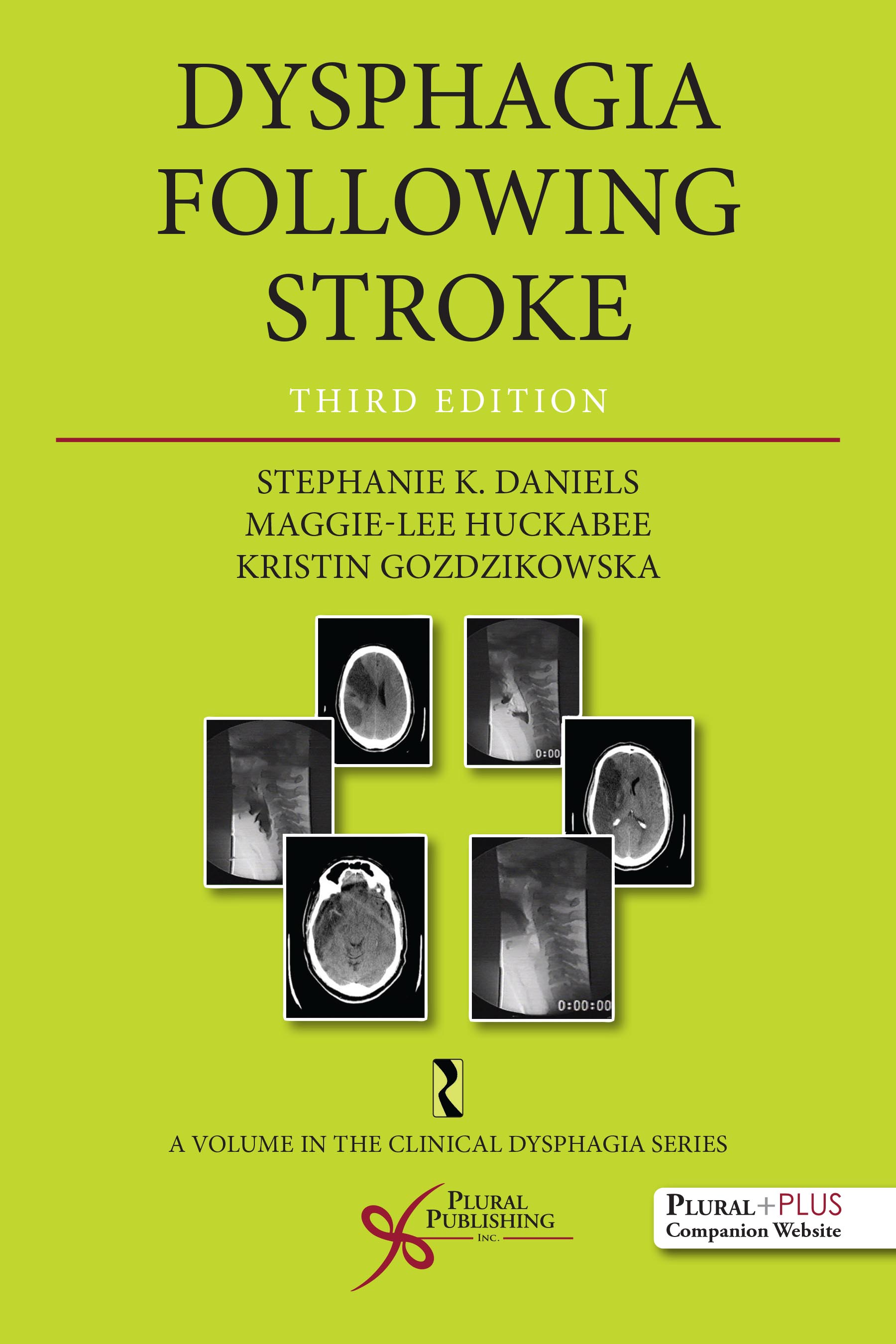
Dysphagia Following Stroke
Third Edition
Stephanie K. Daniels, Maggie-Lee Huckabee, Kristin Gozdzikowska
Details: 500 pages, B&W, Softcover, 6" x 9"
ISBN13: 978-1-63550-030-1
© 2019 | Available
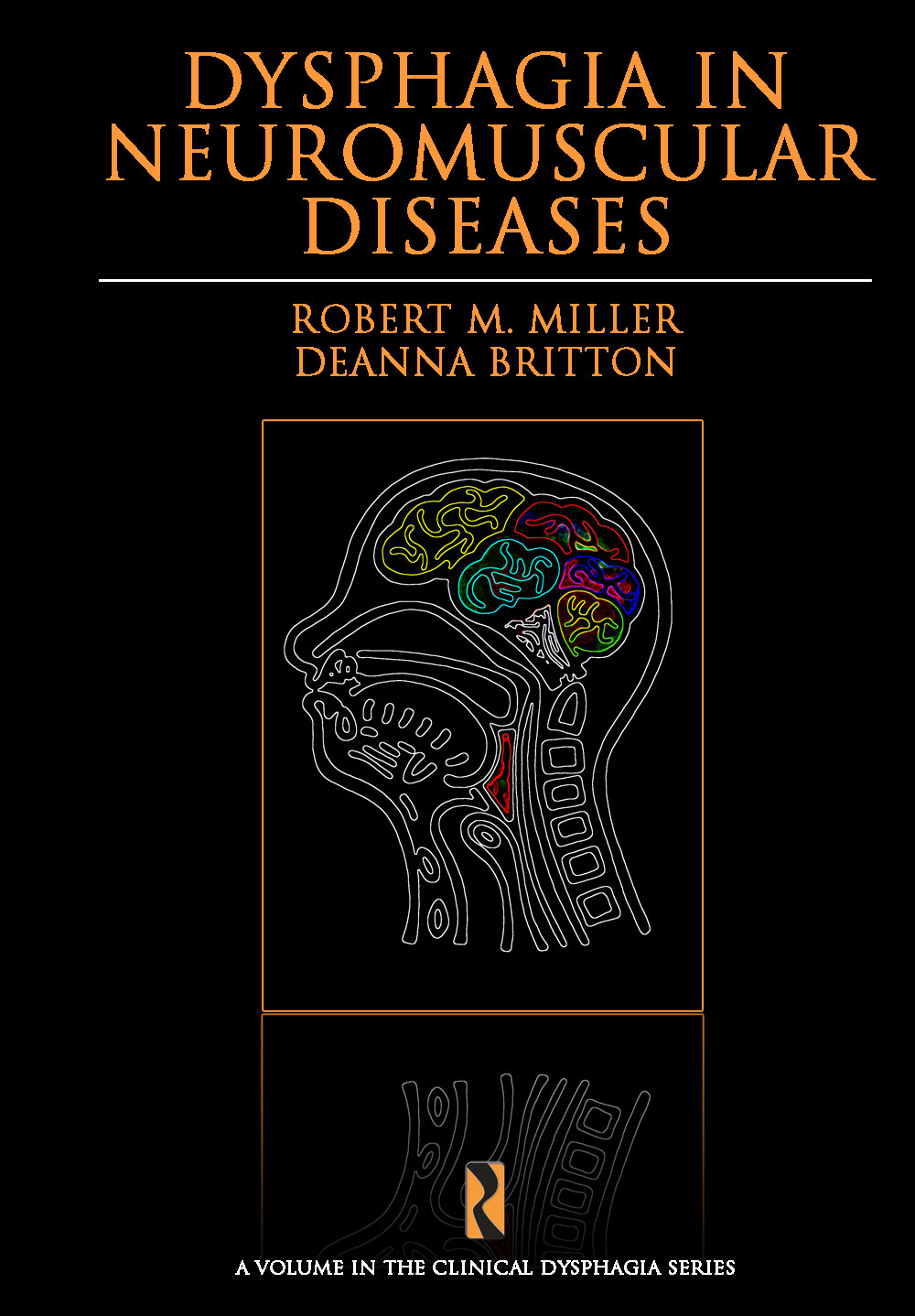
Dysphagia in Neuromuscular Diseases
First Edition
Robert M. Miller, Deanna Britton
Details: 250 pages, B&W, Softcover, 7" x 10"
ISBN13: 978-1-59756-369-7
© 2011 | Available
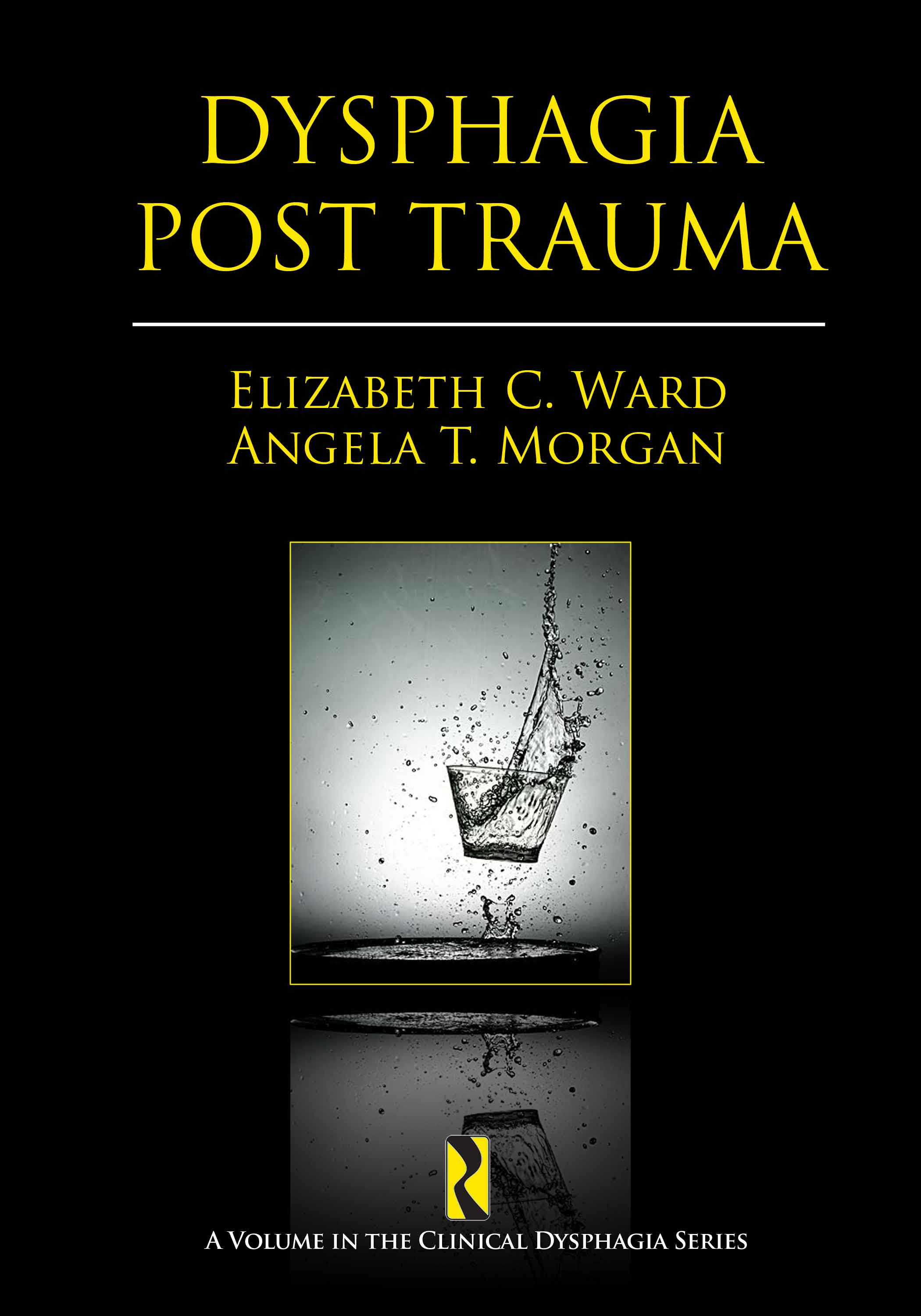
Dysphagia Post Trauma
First Edition
Elizabeth C. Ward, Angela T. Morgan
Details: 264 pages, B&W, Softcover, 7" x 10"
ISBN13: 978-1-59756-236-2
© 2009 | Available
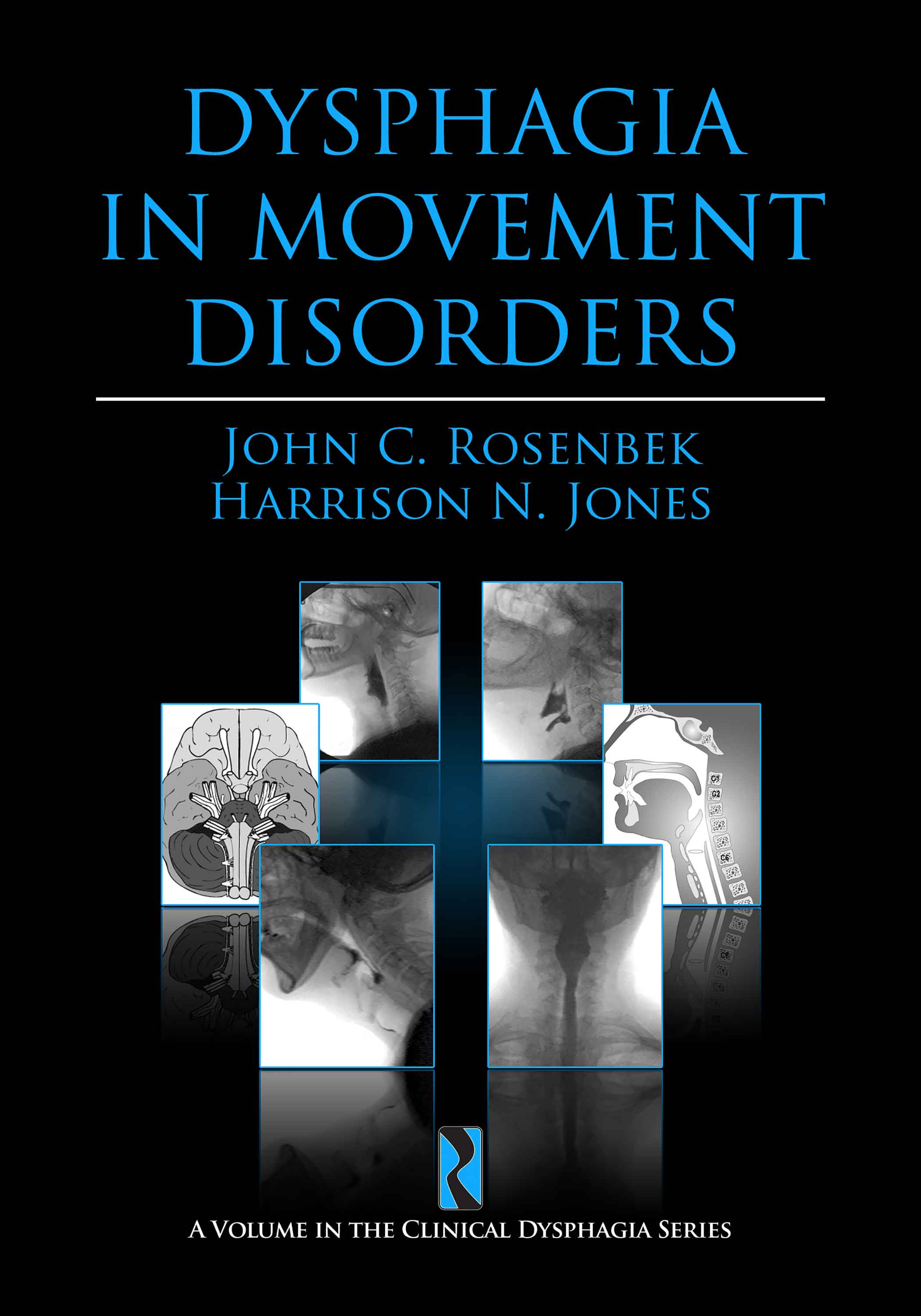
Dysphagia in Movement Disorders
Harrison Jones, John C. Rosenbek
Details: 275 pages, B&W, Softcover, 7" x 10"
ISBN13: 978-1-59756-228-7
© 2009 | Available
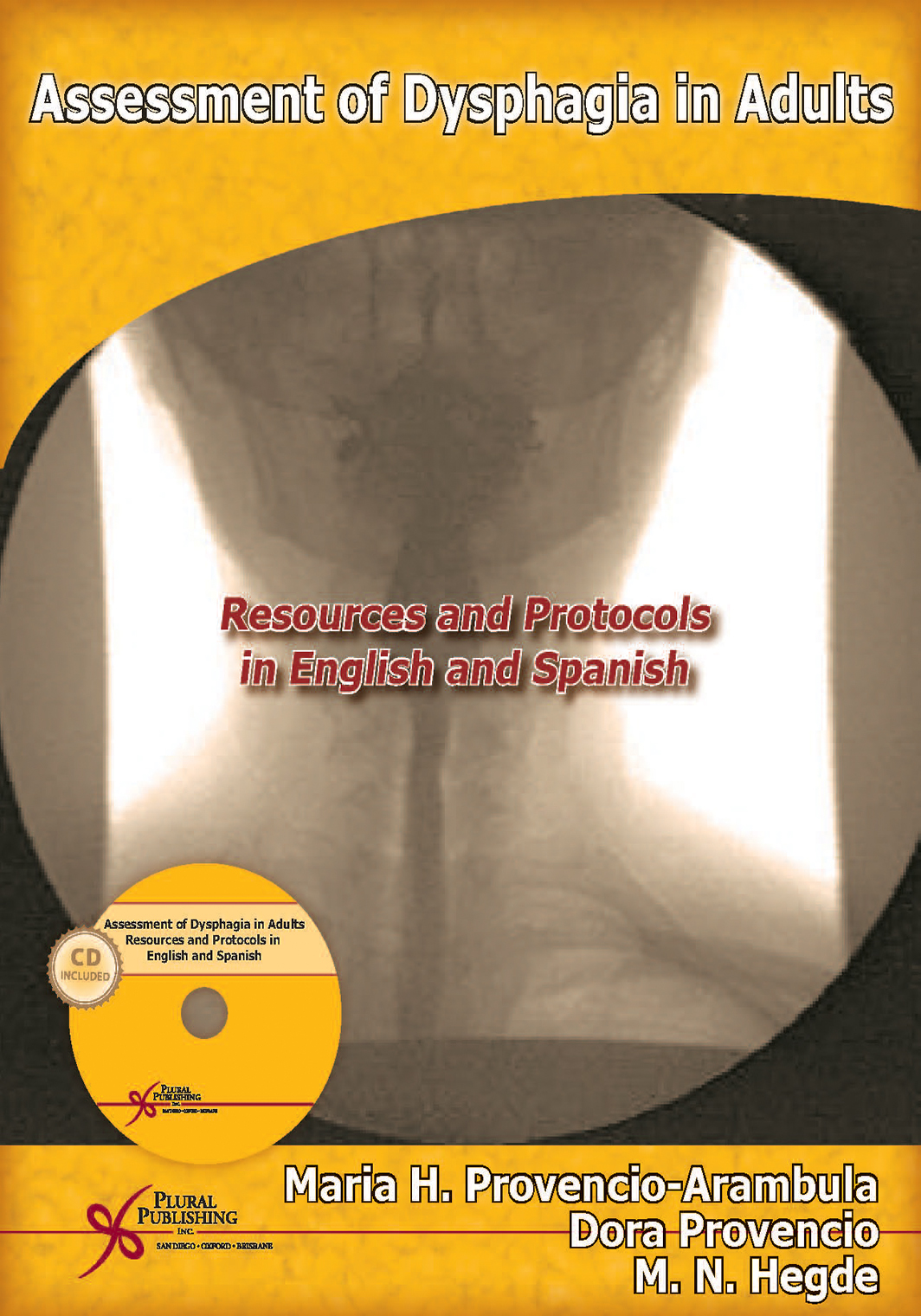
Assessment of Dysphagia in Adults: Resources and Protocols in English and Spanish
First Edition
Maria H. Provencio-Arambula, Dora Provencio, M.N. Hegde
Details: 352 pages, 2-Color, Softcover Layflat, 8.5" x 11"
ISBN13: 978-1-59756-095-5
© 2007 | Available
